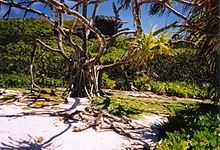Henderson Island (Pitcairn Islands)
| UNESCO World Heritage Site | |
|---|---|
 | |
| Criteria | Natural: vii, x |
| Reference | 487 |
| Inscription | 1988 (12th Session) |
Henderson Island is an uninhabited uplifted coral island in the south Pacific Ocean, annexed to the Pitcairn Islands colony in 1902. Measuring 9.6 kilometres (6.0 mi) long and 5.1 kilometres (3.2 mi) wide, Henderson Island has an area of 37.3 square kilometres (14.4 sq mi) and is located 193 kilometres (120 mi) northeast of Pitcairn Island at 24°22′01″S 128°18′57″W / 24.36694°S 128.31583°W. Henderson Island was designated a World Heritage Site by the United Nations in 1988 because of its bird life and untouched phosphate reserves.

The island itself is too small and steep for agriculture and has no fresh water. The raised coral platform has 15 metres (49 ft) coastal cliffs (mostly undercut) with three beaches on the northern side. It has a maximum elevation of 33 metres (108 ft).
Four land bird species are endemic to the island, the Henderson Crake, Henderson Fruit Dove, Henderson Lorikeet and Henderson Reed-warbler. There are also fifteen non-endemic seabirds. Other endemic species include nine of the sixty-three plant species, four of the sixteen land snail species, and the only butterfly species.
Although Henderson is virtually uninhabitable, archaeological evidence suggests that it was inhabited by a small Polynesian permanent colony between the twelfth and fifteenth centuries until this group disappeared.[1] The reasons for the group's disappearance are unknown, but are probably related to the similar disappearance of the Polynesians on Pitcairn Island, on whom the Hendersonians would have depended for many of the basics of life. The Pitcairn Polynesians may in turn have disappeared because of the decline of nearby Mangareva; thus, Henderson was at the end of a chain of small, dependent colonies of Mangareva.[2]

On January 29, 1606, Henderson island was discovered by Portuguese sailor Pedro Fernandes de Queiros, who named it San João Baptista. On January 17, 1819 the island was re-discovered by British Capt. Henderson of the British East India Company ship Hercules, and named Henderson Island. On March 2, 1819, Captain Henry King, sailing aboard the Elizabeth, landed on the island to find the king's colors already flying. His crew scratched the name of their ship into a tree, and for some years the island's name was Elizabeth or Henderson, interchangeably.
The crew of the Essex landed briefly on the island, staying from December 20, 1820 to December 27, 1820. Three of the crew — Thomas Chappel, Seth Weeks and William Wright — stayed and survived until their subsequent rescue on April 9, 1821 while their companions sailed for South America. The men of the Essex believed they had found Ducie Island. In 1957, a man lived the life of a castaway on the island for approximately two months, accompanied by a pet chimpanzee, apparently as a publicity stunt. He was eventually rescued by people from Pitcairn. [1]

In the early 1980s, American businessman Arthur M. Ratliff expressed interest in buying and leasing Henderson Island, and establishing a small settlement with an airstrip, cattle ranch, and mansion. The Pitcairn Island Council approved his plans in April 1981 but the British Foreign and Commonwealth Office overrode the decision and vetoed the proposed development, after environmentalist groups had lobbied to protect the natural ecology and environment of the island which was subsequently named a World Heritage site. [2]
Since the introduction of aluminium-hulled long-boats in the 20th century, Pitcairners have made regular trips to Henderson to harvest the wood of miro (Thespesia populnea) and tou (Cordia subcordata) trees. Usually they venture to Henderson only once per year, but may make up to three trips if the weather is favorable. Pitcairners carve the wood into curios, from which they derive much of their income.[3]
References
- ^ Stefan, Vincent H. (2002). "Henderson Island crania and their implication for Southeast Polynesian prehistory". Journal of the Polynesian Society.
- ^ Weisler, Marshall I. (1995). "Henderson Island prehistory: colonization and extinction on a remote Polynesian island". Biological Journal of the Linnean Society. 56: 377–404.
{{cite journal}}: Text "issue 1-2" ignored (help) - ^ Brooke, M. de L. (2004). "Henderson Island World Heritage Site Management Plan 2004–2009" (PDF). Foreign and Commonwealth Office, London: 19. Retrieved 2009-03-31.
{{cite journal}}: Cite journal requires|journal=(help); Unknown parameter|coauthors=ignored (|author=suggested) (help)
- Jared Diamond, Collapse: How Societies Choose to Fail or Succeed (2005), ch. 3.
- Nathaniel Philbrick, In the Heart of the Sea: The Tragedy of the Whaleship Essex, Penguin Books 2001.
- Chase, Owen (1821). Narrative of the Most Extraordinary and Distressing Shipwreck of the Whale-Ship Essex. W. B. Gilley. No ISBN. New York.
- Nickerson, Thomas (1984). The Loss of the Ship "Essex" Sunk by a Whale and the Ordeal of the Crew in Open Boats. Nantucket Historical Society. ISBN 9996662497.
External links
24°21′S 128°19′W / 24.350°S 128.317°W
- The Henderson Island Website
- Henderson Island - UNESCO
- Henderson Island - Travel Log
- Henderson Island Henderson Island at Britlink.
- Visiting Henderson Island - R/V Bounty Bay
- Henderson Island Travel Guide from Travellerspoint
- [3] Stan's Leap

